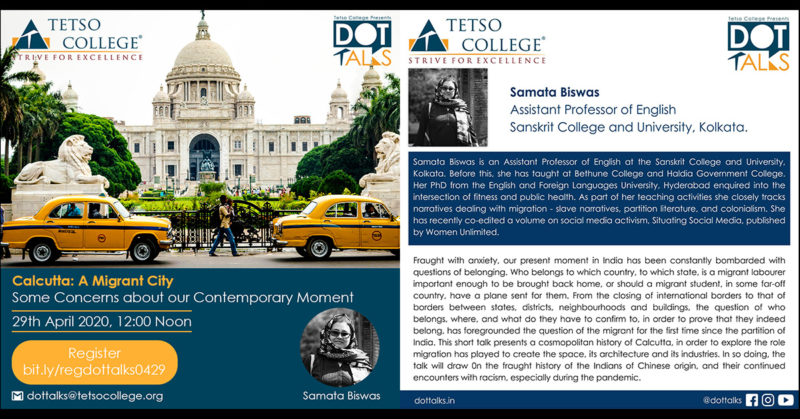DOT Talks in collaboration with Tetso College organised the fourth in its webinar series on the topic “Calcutta: A Migrant City – Some concerns about our contemporary movement” with resource speaker Dr. Samata Biswas and chaired by S. Elika Assumi, Dean of Tetso College. Dr. Biswas is currently an Asst. Prof of English in the Sanskrit College and University, Kolkata. As part of her teaching activities she closely tracks narratives dealing with migration – slave narratives, partition literature, and communalism.
Dr. Biswas began by giving the reason why she wanted to speak on the topic she chose which was because she and her research group were considering the question of migration spaces for a very long time. With regards to the recent lockdown due to the COVID-19 pandemic, she talked about how the whole nation saw with great amazement and horror the masses of migrants trying to walk back to their homes which were about a few hundreds or thousands of kilometres. Why did this happen? Because they did not have any source of income anymore or money to pay the rent and for food. Even today she said that there was news about deaths occurring due to lack of food having walked kilometres on foot. So this leads to the question again of the reasons of these migrants being in the city. Why were they here? What were they doing in the city? To find such answers we need to look at the history of Calcutta, but looking at the history of Calcutta would also ask the same question – Who is a native of Calcutta and who is the outsider?
She used the examples of the North-Eastern people and the Chinese Indians or anybody who did not fit into the picture of the mainstream Indians. She said that if they were present in Calcutta during the past four or five months, they would have been addressed as “Coronavirus”. This she regarded was because they did not fit into the image of the mainstream Indians. Also, there were reports on boycotts across Calcutta against Chinese eateries because they thought that the people would catch the virus through their food. But these people have not been to China for three generations, she added.
The question was how Calcutta had so many Chinese Eateries and the question of the migrants in the city of Calcutta. To get answers to these she said that we would have to trace back to the history of the formal capital of British India to its foundation and development of which everything is built by and with migrants. She used the work of J. Colesworthy Grant, called “An Anglo Indian Domestic Sketch” published in 1849, where the author describes about the city’s neighbours where Calcutta was a flourishing market with many people who were a diversified group of Persians, Arabs, Jews, Marwarees, Americans, Madrasees, Sikhs, Turks, Parsees, Chinese, Burmese and Bengalee.
She also took the examples of various architectures to talk about the influences of migrants in the culture of the city of Calcutta. Some of them were, Chowringhee Mansion, Maghen David Synagogue, and many more. The Chinese were brought in to the city as indentured labourers, slaves, and were escapees and were also excellent carpenters. She also talked about the Cirsuits of Labour Migration from which the practices of the hand-pulled rickshaws and the cycle van were borrowed with the coming of the Chinese.
The migrants have been working in Calcutta for many generations and have come from various places and have been living in slums or thatched houses for many generations. They worked as sweepers, sugar planters, cleaners, scavengers, electricians, etc. These migrants had moulded, created, recreated, and shaped the city both topographically and in spirit, she stated.
Dr. Biswas also talked about the role of migrant women, where she addressed on the subject of how these women were involved in work or participation in any field. The role of migrant women in shaping Calcutta has not merely been one of exploitation; they have also been at the forefront of the women participation in employment. She used the example of Meeta from “Meghe Dhaka Tara” who was an actress in one of the three first films during the 1960s. Refugee women were already participating in paid labour force much later than women from the city itself. These women worked as nurses, secretaries, etc.. They also had jobs but still lived in huts or makeshift homes.
She ended the presentation by leaving a question, “what happens when we forget our history especially of marginalization and discrimination? Are we then doomed to repeat it? Are we running around our past?”
This was followed by the question and answer/interactive round where the attendees of the webinar raised various questions to the speaker. The webinar ended with the chairperson encouraging the viewers to keep joining such webinars which will keep continuing in the future as well.

